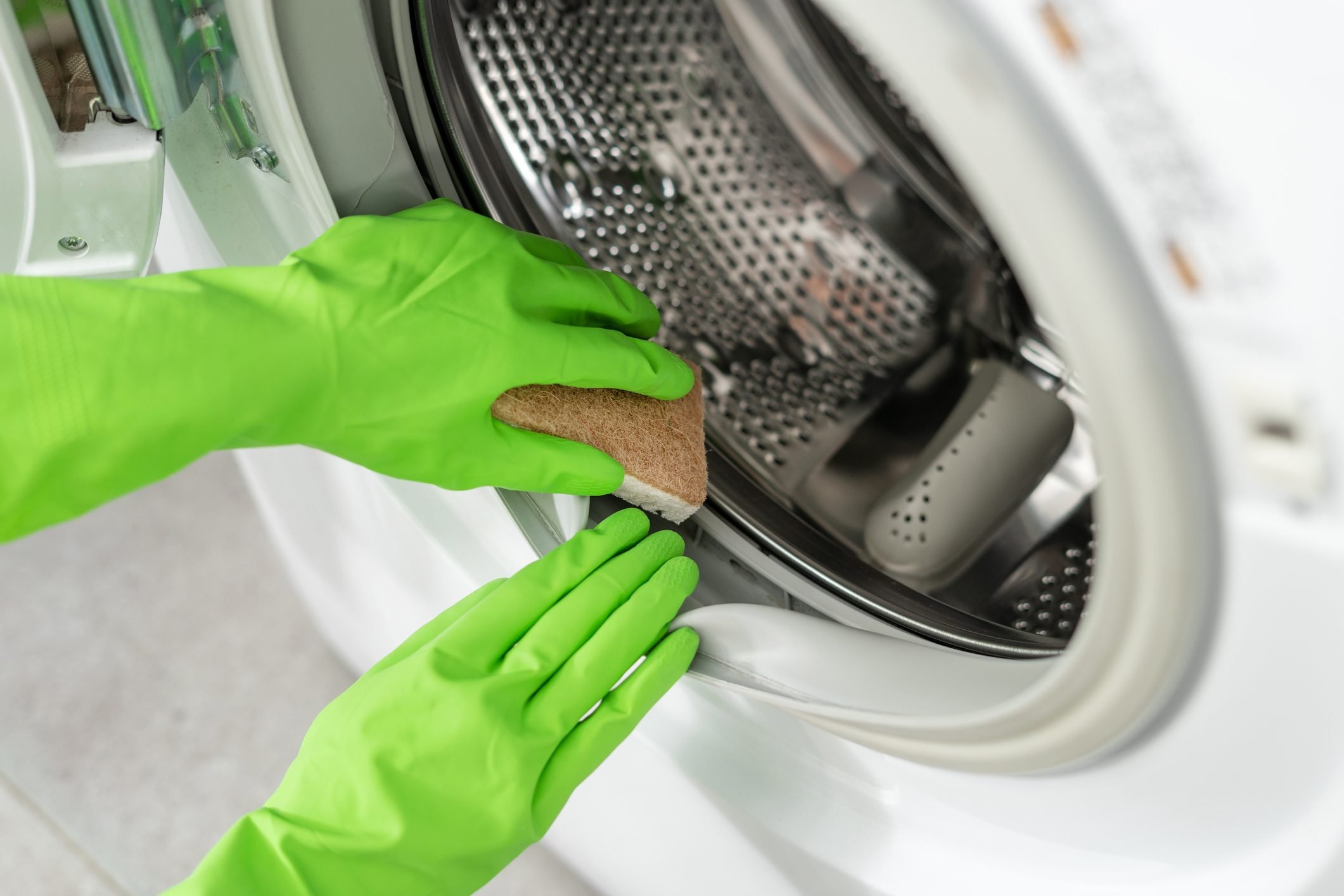Washing machines take a lot of abuse — hard water, harsh chemicals, soccer uniforms. Keep these indispensable appliances mold-free with these tips.

Tips To Get Rid of Mold in Your Washing Machine

Mold exists everywhere — in the air, in the dirt, in our homes and yes, in our washing machines. Mold spores travel great distances, hitchhiking on a breeze or a soft cashmere sweater. When they settle on something damp, they start to grow.
It’s nearly impossible to get rid of mold. Molds eat building materials like wood, drywall and paint, and they destroy everything in their wake. Sure, that sounds grim. But without molds, forest floors couldn’t break down leaves, and we wouldn’t have cheese.
But no one wants smelly mold in the washing machine, no matter how much they love a good cheddar. Molds irritate allergy sufferers and cause millions of dollars in property damage each year.
Short of beating our clothes on a rock at the local stream, we have to deal with mold in our washing machines. Read on for tips on keeping your washer mold-free.
On This Page
Why Is There Mold In My Washing Machine?
Molds require three things washing machines provide: water, oxygen and food. Water and oxygen are self-explanatory, but food? What do molds eat? Just about everything, according to the Centers for Disease Control and Prevention (CDC).
In a washing machine, that food is detergent, fabric softener residue and dirt from clothes.
How To Get Rid of Mold In Washing Machine
Getting rid of mold means killing and removing mold that’s established, and minimizing conditions that cause it to thrive so it doesn’t come back.
First, let’s focus on getting rid of mold. There are a few ways:
Borax and vinegar
A gallon of vinegar and a pound of Borax is the preferred recipe of Patric Richardson, the Laundry Evangelist. Borax and vinegar are naturally-occurring antifungals, and together they pack a wallop.
Run the combo on the longest, hottest cycle to kill mold in the drum and hoses. Doing this routine every three to six months will prevent it from coming back.
Chlorine bleach
Bleach is an effective mold killer, according to the CDC. Run a cup of liquid chlorine bleach through a cycle — the longer and hotter the better. When the cycle finishes, wipe the door and its gasket with a solution of one-third cup bleach per three-quarters of a gallon of water.
Vinegar and baking soda
Vinegar is a washing machine miracle worker. It works by itself, with Borax and with baking soda. To use with baking soda, sprinkle about a cup of the powder in the bottom of the drum, then fill the detergent tray with vinegar. Run on a hot cycle.
Physical removal
Mix any of the above concoctions and physically remove mold with a microfiber cloth, sponge or brush. A toothbrush effectively cleans nooks and crannies.
- Remove the detergent tray, scrub, rinse and air dry;
- Soak a microfiber cloth with disinfecting solution and clean the door, the drum and the gasket;
- Clean the washing machine filter, which can harbor molds.
How To Prevent Mold In a Washing Machine
Once you’ve rid your washing machine of mold, keep it out. Mold establishes quickly given the right environment. In 24 to 48 hours, your washing machine could become a haven even if you just cleaned it.
Keep mold from growing back with these simple steps:
Leave the door and tray open
Molds don’t need a puddle of standing water to thrive. A damp, humid environment, like right after you remove a load of clothes, works just fine. Once you’re done with laundry, leave the washing machine door open to allow air to circulate inside the drum.
The same goes for the tray where you add the detergent. Remove or leave it open in between washes to allow it to dry. Once a month, take it out and clean it with vinegar to remove detergent buildup.
Dry the door seal gasket
Front-loading washing machines save water and clean better than top-loaders, but they have one drawback: the door gasket tends to hold on to moisture and grow mold. After your last load of the day, dry the inside of the gasket all the way around the door to remove trapped water.
Once a month, wipe down the gasket with a bleach and water solution — one-third cup bleach to three-quarters of a gallon of water.
Wipe down the door
If you have pets, you’ve probably noticed dog and cat hair often clings to the inside of the door. Pet hair and other fibers hold on to water, so grab a towel and wipe down the door. This will clean off excess detergent and other mold-friendly residues, too.
Once a month, clean the inside of the door with bleach and water solution.
Run the self-clean cycle
Newer washers come with a self-cleaning cycle. This cycle uses extremely hot water and a special spin to remove and prevent mold. If your model does not have this cycle, do the DIY bleach or vinegar and the Borax method mentioned above.
Check your machine’s user manual. The manufacturer may recommend a specific product.
Use less stuff
Most people use way too much detergent, Richardson says. You only need about two tablespoons for a medium-sized load. Detergents are concentrated, so if you use too much the rinse cycle can’t remove it all.
Fabric softeners stay on clothing so they’ll stay in your washer, too. De-gunk your washing machine with Borax and vinegar. Or use a commercial product like Affresh, especially if you’re a heavy laundry product user.




















